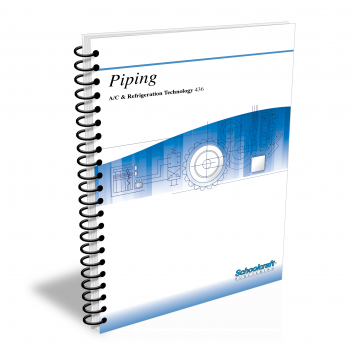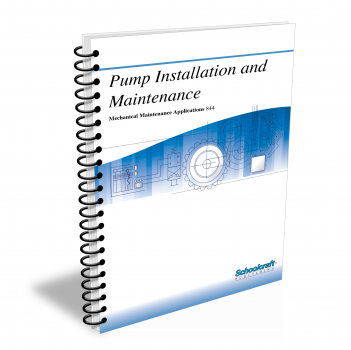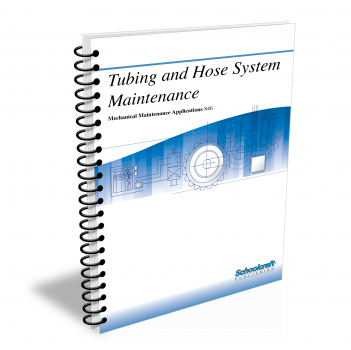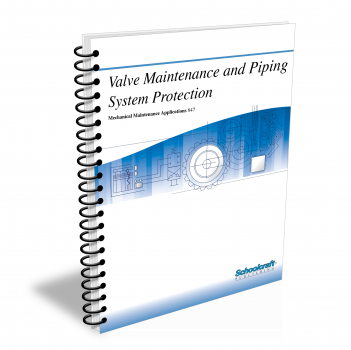Maintenance Pipefitting
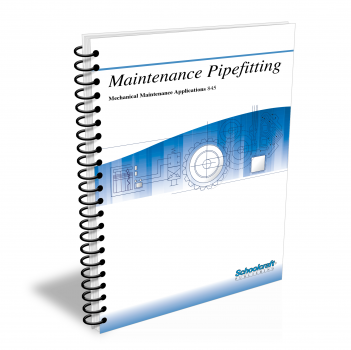
Course Number: 845
The Maintenance Pipefitting textbook covers components and terminology used in piping systems. It also covers terminology, measurement, and maintenance of threaded, welded, and plastic piping systems. The use of pipefitting accessories—supports, traps, filters and strainers, and expansion joints' is also explained.
Does your curriculum require additional topics not included in this textbook? Build a customized version of the Maintenance Pipefitting textbook below.
Recommended Contact Hours – 8
Preview a Chapter
Available Supporting Material
- Table of Contents
- Exam Copies
- Suggested Titles
Table of Contents
Chapter 1: Piping Dimensions and Terminology
Topics: Piping standards, dimensions, and symbols; Pipe fittings; Flanges; Using dimensional tables; Calculating length; Straight and rolling offsets
Learning Objectives:
- State whether ID or OD identifies a given nominal pipe size.
- Given a nominal pipe size and a copy of the American Standard Code for Pressure Piping, find the wall thickness of a pipe of a given schedule number.
- Name at least four kinds of pipe fittings.
- Given a schematic drawing of a piping system, identify all fittings used in the system.
- Given a drawing showing three lengths of pipe with and without fittings installed, correctly name the application dimension for measuring the pipe length.
- Given a schematic drawing showing two parallel horizontal pipe runs with a 45 run connection, identify the travel, set, and face-to-face length.
Chapter 2: Threaded Piping Systems
Topics: Thread terminology; Measuring pipe threads; Measuring, cutting, threading, and finishing pipe; Sealants; Assembly; Emergency repair
Learning Objectives:
- Given a descriptive number, identify the pipe size, thread type, and number of threads per inch on a threaded pipe.
- Given a length of unthreaded pipe and required thread specifications, thread one end of the pipe to meet the specifications.
- Given a length of threaded pipe and two threaded fittings, prepare the parts, apply the proper compound, and assemble the components.
- State the important parts of a pipe thread.
- Given actual dimensions for travel and set of a threaded pipe and fitting assembly, use established dimensional tables to compute the total length of replacement pipe needed.
Chapter 3: Welded Piping Systems
Topics: Welded pipe fittings; Welding rings; System alignment; Preparing the work; Squaring the flange; Weld cracks; Inspection; Repair
Learning Objectives:
- Explain what steps to take to prepare lengths of pipe for butt and fillet welding.
- Name the welding ring material used with stainless steel or nickel alloy piping.
- Explain squareness and its importance in a welded piping system.
- Name the major assembly considerations when fabricating flanged connections for a rolling offset installation.
- Given a schematic drawing of this installation, compute the hole compensation angle to be used when positioning the flange for welding.
- Name at least one accessory used to help align two sections of pipe for welding.
- Given a length of pipe and a slip-on flange with a raised face, align and weld the pipe and flange.
Chapter 4: Plastic Piping Systems
Topics: Thermoplastic, thermosetting pipe, Advantages and disadvantages of plastic pipe; Installation; Troubleshooting
Learning Objectives:
- Name the materials used for plastic pipes and fittings.
- Name at least one advantage of plastic piping.
- Name the two most common materials used to make thermosetting plastic pipe.
- Given two lengths of thermosetting plastic pipe, demonstrate how to join then with a bell and spigot joint.
- Name at least one limitation of plastic piping.
- Demonstrate how to align and install fittings on a length of plastic pipe.
Chapter 5: Pipefitting Accessories
Topics: Hangers and supports; Special mountings; Steam trap installation and cleaning; Filter, strainer, and separator installation and cleaning; Expansion joints
Learning Objectives:
- Name the three classes of piping supports and hangers.
- Explain which two types of pipe hangers are most often used to reduce line vibration and shock.
- Explain the factors to be considered when installing pipe hangers for different applications.
- Name the piping system components used to compensate for pipe length changes due to temperature changes.
- Explain the factors to be considered when locating (spacing) pipe hangers in a system.
- in locating them.
- Explain the purpose of a line filter.
Request Exam Copies
Exam Copies
Ready to see a copy of our textbooks? After selecting which textbooks you’d like to review for your course, you can submit your request by either logging in or creating an account so we know where to ship your exam copies. A representative from Schoolcraft will contact you to confirm and finish processing your request.
Exam copies are always free and yours to keep.
Selected Exam Copies
none selected
* Maximum of five copies can be ordered
